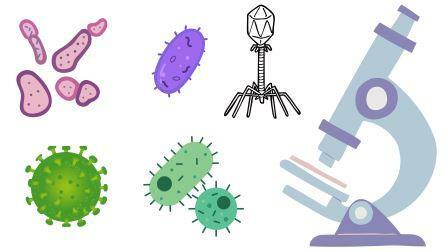Q- Name one example of each of diseases caused by bacteria, viruses, and protozoans
Answer- Disease caused due to bacteria- Tuberculosis
Disease caused due to Virus- Smallpox
Disease caused due to Protozoans- Malaria
Important Questions for Class 9th
- Define Infectious disease. Give two examples.
- What are disease agents? Give two examples.
- Give two examples of acute diseases.
We hope that the above answer will be very helpful for you. The above question asked to name one example of each of the diseases caused by bacteria viruses and protozoans.
So, we provided you with one example of each disease. If you want to learn more about bacteria, viruses, and protozoans so you can read the content given below but before going to read it we would like to provide you with some other important answers for class 9th students.
These questions are very important and you should learn the answers to these questions. The answer to each question can be seen by clicking on that question.
Bacteria
Bacteria are ubiquitous, free-living organisms often consisting of one biological cell (Unicellular in nature). They constitute a large part of prokaryotic microorganisms.
Bacteria are about a few micrometers in length, bacteria were among the first life forms to appear on the planet Earth, and are present in most of its habitats.
The word bacteria is the plural of a Latin term whose singular term is ‘bacterium’. Bacteria generally inhabitants in different conditions such as soil, water, radioactive waste, acidic hot springs, and the deep biosphere of the planet Earth’s crust layer.
Bacteria play a vital role in many stages of the nutrient cycle by recycling nutrients such as the fixation of nitrogen from the atmosphere (Nitrogen Fixation process).
The nutrient cycle includes the decomposition of dead bodies in which bacteria are responsible for the putrefaction stage in this cycle.
In the biological communities surrounding hydrothermal vents and cold seeps, extremophile bacteria provide all the nutrients which are needed to sustain life by converting dissolved compounds (dissolved substances), such as hydrogen sulfide and methane, to energy.
Bacteria also live in parasitic as well as symbiotic relationships with both plants and animals.
Most bacteria have not been characterized and there are many species that cannot be grown in the laboratory easily.
The study of bacteria is known as bacteriology which is also a branch of microbiology. There are different diseases that are caused due to bacteria. These diseases are also called bacterial diseases.
Some examples of bacterial diseases are Tuberculosis, Leptospirosis, Pneumonia, Tetanus, Pseudomonas Infection, Cholera, Anthrax, and Botulism.
Virus
Viruses are those infectious agents that can multiply only in living cells of animals, plants, or bacteria.
The name ‘Virus’ is taken from a Latin word meaning “slimy liquid” or “poison”. The virus is small-sized and has a very simple composition.
These microorganisms are more harmful than bacteria. The studies of Russian scientist Dmitry I. Ivanovsky in the year 1892 earliest is an indication of the biological nature of viruses.
One of the popular scientists Beijerinck first surmised that the virus under study was a new kind of infectious agent, which he designated contagium vivum fluidum, meaning that it was still alive, reproducing organism that differed from other organisms.

After a long investigation, the scientists found that a disease of tobacco plants could be transmitted by an agent, which was later called tobacco mosaic virus, passing through a minute filter that would not allow the passage of bacteria in it.
This virus and those subsequently isolated organisms that cannot grow on an artificial medium and were not visible under the light microscope.
In independent studies in the year 1915 by Frederick W. Twort (British investigator) and in the year 1917 by the French Canadian scientist Félix H. d’Hérelle, lesions in cultures of bacteria were discovered and attributed to an agent called bacteriophage, which was later called “eater of bacteria”.
Some of the examples of diseases that are caused due to viruses are measles, rubella, fifth disease, chikungunya virus infection, smallpox, chickenpox/shingles, and roseola.
Protozoan
Protozoa are unicellular organisms or single-celled organisms. They come in many different shapes and sizes ranging from an Amoeba which can change its shape easily to Paramecium with its fixed shape and size.
The structure of paramecium is generally very complex. They live in a wide variety of moist habitats including freshwater, marine environments, and soil.
All protozoans are heterotrophic in nature. All protozoans are eukaryotes and therefore have a “true,” or membrane-bounded, nucleus.
Modern ultrastructural, biochemical, and genetic evidence has rendered the term protozoan highly problematic.
For example, a protozoan was historically referred to as a protist that has its own traits just like animals, such as the ability to move through the water.
Protozoans traditionally were thought to be the progenitors of modern animals, but contemporary evidence has revealed that this is not the case for all the protozoans of protozoan species.
In fact, modern science has shown that the protozoans represent a very complicated grouping of microorganisms that do not necessarily share a common evolutionary history about them.
This unrelated and paraphyletic nature of the protozoans has caused scientists to abandon the term protozoan in formal classification schemes.
Hence, the subkingdom Protozoa is today considered to be as obsolete. Today the term protozoan is used informally in reference to nonfilamentous heterotrophic protists.
The protozoans are responsible for causing several diseases such as Malaria, African trypanosomiasis, Chagas disease, Leishmaniasis, Toxoplasmosis and Cryptosporidiosis.
